cycle 3
Posted: December 10, 2024 Filed under: Uncategorized Leave a comment »For the third iteration of my project, I added in additional elements of a contact mic tracking my heart beat and a large scale projection of my blinking eye. I stood in front of the large eye projection and performed my movements with the smaller face projection trained on my face at all times.

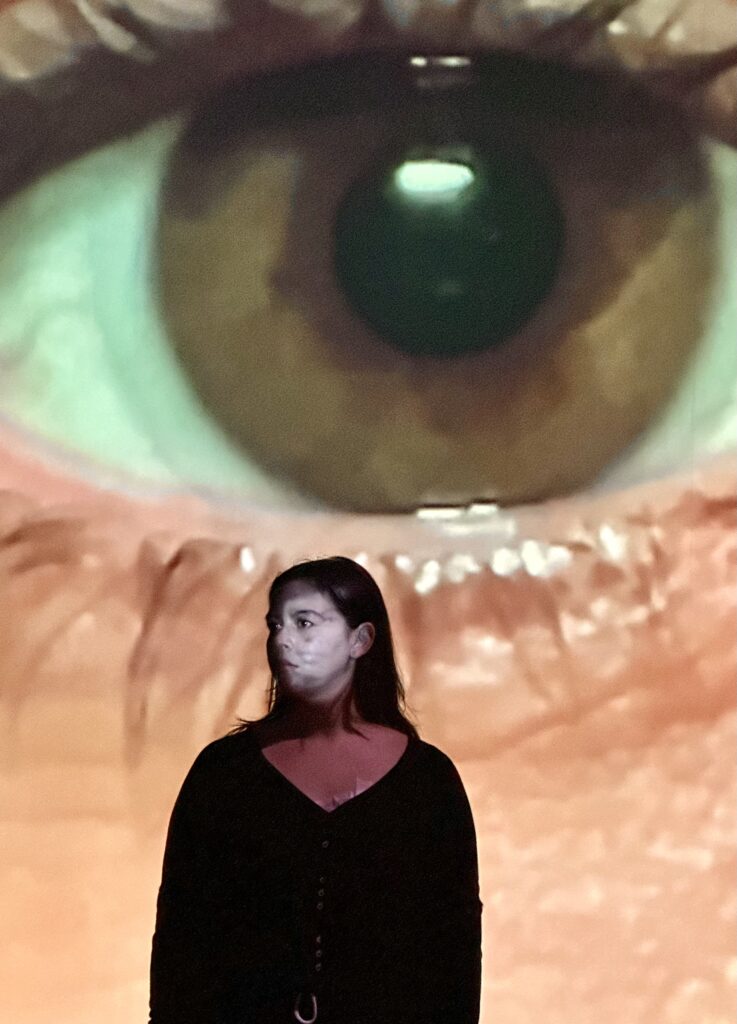
The performance was a 7 minute duration, but in the future I could see it being much longer–potentially 30-45. The movements that are the score of the piece are my slow, measured blinkings that sync in and out with the blinking done by the image projected onto my face and the large eye projection, as well as the deliberate and slow movements of my head turning from left to right. My movements are slow to the point that it takes 7 minutes to turn from center to the right, back to center, and then to the left.
The addition of the contact mic picking up my heartbeat felt vital to the piece. With the help of Michael at MOLA, I was able to narrow in on the low frequencies of my heart beating and had that play for the duration of the performance. It felt crucial to be a live sound, as it was really evident how much it would change according to what was happening. For instance, it was quite fast at the beginning and then gradually slowed throughout, or it would speed up if someone moved around in the audience. The feedback I got was that it felt clear that it wasn’t pre-recorded because of how it felt tied to my physical presence in the room as audience members could see me breathe.
Besides increasing the duration of the piece, something I would consider changing in a future iteration would be providing subtle clues to the audience that they would be allowed to come closer to my body as I performed. Some clues I would consider would be a sign outside of the performance space that said something like “viewers are invited to look closely at the artist, but to not touch her,” or perhaps include a variety of seating at different viewing distances. Especially in the case of a longer durational piece, seating would become an invitation to stay and look. I was also appreciative of the monitor that was provided to me so I could “mark” my movements, and it made me remember that I had at one point considered having a live feed in the space that showed the performance in a different light; perhaps with a time delay? Alex pointed out that that could be a good idea, especially because there were many layers of mediation happening within the performance already.
I am really proud of this piece. It’s an idea that I had early on in the semester, and I’m really glad I stuck with it and spent the whole 3 cycles dedicated to broadening the performance.
cycle 2
Posted: November 19, 2024 Filed under: Uncategorized Leave a comment »For cycle 2, I played with some ideas for projecting behind my live performance. I made a few different patches with the goal that it could be projected on a large scale in the motion lab as an accompanying piece to my live performance


For the live performance, I have decided to have the projection of my dad’s face with the cut-out eyes fading in and out of opacity. I think that this addition could add to the visual confusion and legibility, and could potentially make the audience feel confusion as to what they were watching.
Because the performance is based around slow movement, there is a lot of subtlety to the piece. I want my movements to feel deliberate and have a score to them, so I will be doing some movement practices to work with that. Alisha gave me the feedback that it might be interesting to explore facial movements as the image that is projected is very placid. This idea terrifies me! I like it.
I also added a sound element to accompany the performance. I used an app called “Hear My Heart” that essentially is a very sensitive mic. The mic picks up your heart beat, but it also has a lot of wooshing. The feedback that I received was that the sound was difficult to decipher as being an actual heart, so I want to experiment with a stronger mic; one that doesn’t have as much interference. It was also unpleasant to have to hold my phone’s mic during the performance.
The patches that I designed on Isadora ultimately feel like they’re from a different world than the performance. I took a very close video of my eye blinking on the same beat as the stop-motion video/the live performance. The initial patches were mirrored and distorted to make the eye feel sort of terrifying, which doesn’t feel like it fits with the emotional feel of the performance. In class, we stripped away the effects and the video was then just an eye blinking. I will for the next cycle re-record this clip and try projecting it behind me.




Cycle 1 Documentation
Posted: November 7, 2024 Filed under: Uncategorized Leave a comment »For cycle 1, I performed an early draft of my idea for cycle #3.
I am interested in intergenerational story-telling, and how our bodies are containers and expressions of time. I have lately been doing meditative performances with my family that involve blinking on a slow count of 8, as I’m curious about how our counts fall in and out of sync with each other. To add some visual complication to this otherwise simple thought, I performed this meditation with a projected video on my face. The projection is a sort of stop-motion collage made out of photos of my dad’s face. The original image is a black and white photo, so I placed a cut-out of his face onto a sort of fleshy pink background. The image is printed on rice paper which adds a sort of haziness to the lines, and its translucency adds a blush of pink to the grey tones. The stop motion element is me placing cut-outs of his eyes shut on top of the image. I then scanned 30 variations of this simple collage and imported them into a premiere sequence and exported it as a video, which became the projected material.
I performed this for about a minute and a half. I have been thinking about it as a durational performance, so I am interested in how it would feel as a full 15 minute experience, or even longer.
I was really excited by the feedback, especially with questions around the “music” of the piece. I loved the idea of including sound elements, especially ones that solidify this idea of internal time keeping. I’ve been experimenting with some heartbeat recording and want to think about how that could be used in the piece. I was also interested in how the audience experienced forgetting that I was a part of the piece. In the future, I’m going to include some shifts in opacity to narrow in on this question of fading legibility. I also might want to add in some variations on movement, but I want to talk to some more people about this.
I’m also running into some issues with the projector itself… It’s maybe too strong for my eyes. I might play with just darkening the overall projection, or trying to buy a projector with even less lumens. Overall, I’m really pleased with this performance.
Pressure Project 3
Posted: October 30, 2024 Filed under: Uncategorized Leave a comment »Recently an area of my art-making has been rooted in archival research. I’m curious about our human instincts to keep records and return to memory, and I wonder about the role remembering plays in the human experience. For this project I used sheet music that I found while exploring a community digital archive called “Watsonville is in the Heart.” This community project is maintained by the descendants and relatives of the “manong generation,” which is the term used to talk about the Filipino men who immigrated to California and worked as migrant farmers in the early 20th century. I have a personal connection to this, as my great-great uncle Dionisio Duque was among that first wave of immigrants. I don’t have a lot of information about him or his life during this time, so doing this kind of archival investigation feeds some of this curiosity.
Here is the original sheet music. This music was hand-written by a man named Arsenio Lopez; he and a few other gentlemen would play music at cultural events and parties together. This song, “Dahil Say-yo,” is a famous Filipino love song (called a “Kundiman”).
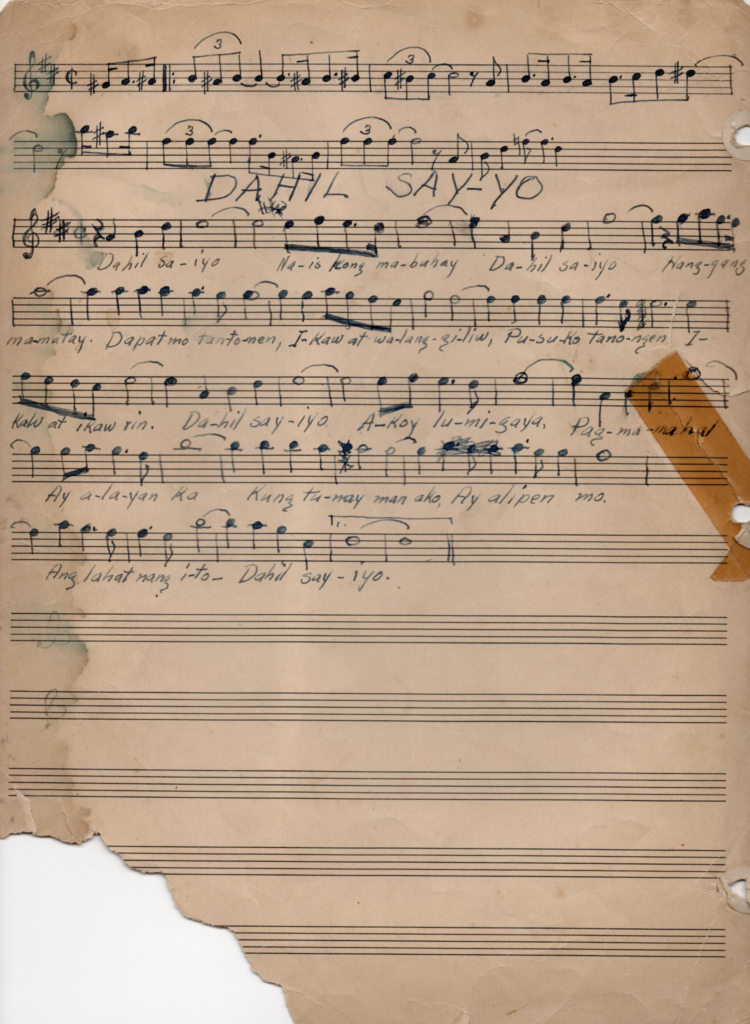
Arsenio was a saxophonist, and so is my brother! So the next step of my sound piece involved asking my brother if he could send me a recording of him playing this song. After he sent it to me, I added some record snaps and pops from freesound.org and played with some distortions to try and make his recording sound a little tinny. Because the music notation had words included, it made me think that this song needed a vocal element as well. I did a few recordings of me singing and humming in different octaves, and then added those into the track. I made the humming quite faint and only come in at the beginning and end, and added some reverb and other slight alterations to the highest octave vocal track. I wanted the highest octave to sound sort of haunting and distant, and this is the track that continues for most of the piece. The lower octave voice joins in halfway and sings with her.
As the source material felt important to me, I wanted to include it in some way. I decided to make a diptych with the sheet music and did my own “annotations,” taking some inspiration from illuminated manuscripts. The piece to me is about reaching for something, and the moments where something reaches back to you. I included tracings, transfers, drawings, and collaged elements of his and his wife’s hands.
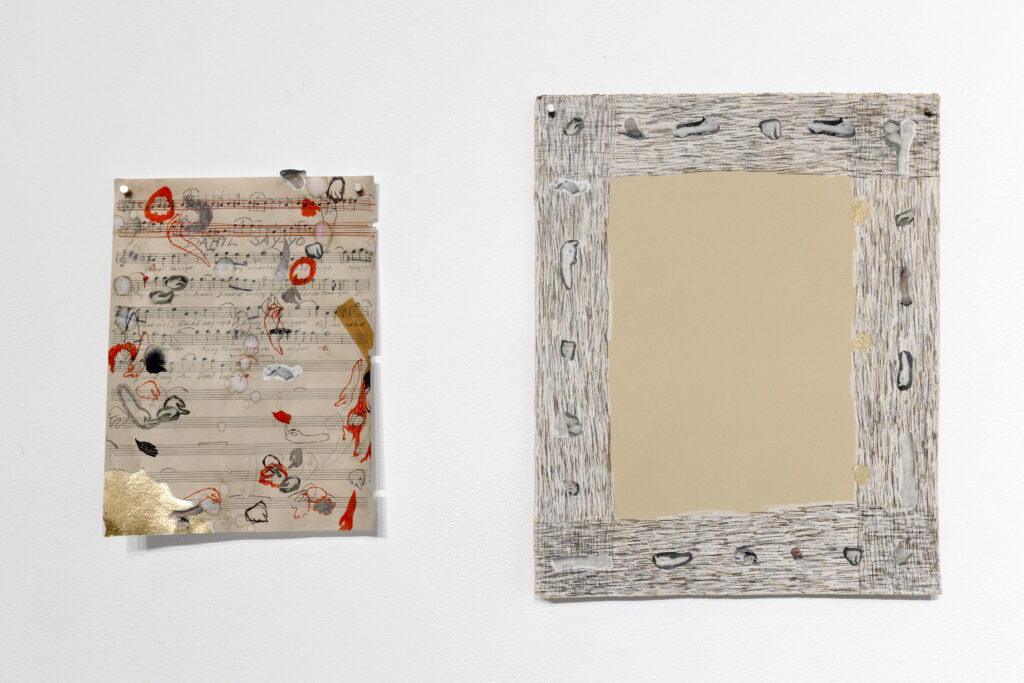
At our presentation, I was so pleased that a lot of my thoughts and concepts came through for the group. I was especially interested in the conversations that came out about lullabies, and how the songs we sing to our children are especially important carriers of memory and culture.
Pressure Project 2: Mystery Door
Posted: October 15, 2024 Filed under: Uncategorized Leave a comment »For pressure project #2, Alisha and I decided to work together in order to create our mysterious door experience. We decided to use the resources of a webcam rather than a depth sensor through Isadora, as well as a projector and a MakeyMakey. It was really helpful working with another person for this project, as tech frustration is easier to manage with another person there to work through troubleshooting.
Our initial steps towards designing an interactive experience were MakeyMakey explorations. We were interested in using pencils to draw conductive “buttons” and practiced drawing on top of images to see if that could lead us somewhere. Those first tests were interesting, and might come into my work in the future, but we ultimately decided to use those concepts to make touching the door be a trigger for our Isadora patch.
With the goal to entice a participant into touching the doorknob, we decided we needed to design an Isadora patch (to eventually be projected onto the door) that would pull someone in. We decided to use the webcam as a sensor that would trigger a change in the projection, thinking that it would provide a sort of visual reward for coming closer to the door. So for instance, if the initial projection was a red, hypnotic swirl that then flickers into a red swirl when the webcam senses someone approaching, the hope is that a participant would feel a dopamine rush in realizing they are “supposed” to approach. This brought up some evaluations after our performance about color psychology, as sometimes the color changes felt more alarming than alluring.
Here is a video of the looping projection:
Here is a screenshot of the patch:

The next step towards activating the MakeyMakey was compelling the participant to stand on the “ground” element before touching the door. We made a floor pad out of aluminum foil that was labeled “foot” as well as some cute cut out stars to make the aluminum foil look a little more fancy.
The MakeyMakey alligator clips were clipped to the ground, and then also to the door. When the participant stands on the foil and then touches the door, which completes the circuit, and triggers a sound clip that plays through Isadora. Here is the patch for the MakeyMakey sound trigger:
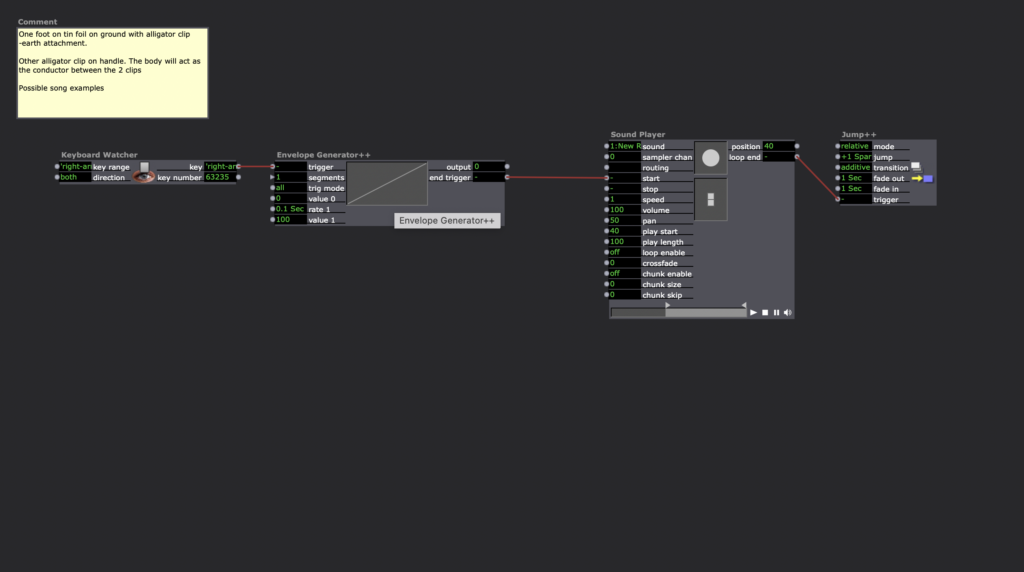
Touching the door triggers a sound command that says “Open,” and we used some basic human psychology to time a second sound to play on a delay. We calculated that there would be about a second of time in between someone touching the handle, hearing the command “open,” and then opening the door, so after a second, Isadora played a twinkling sound that goes along with the door opening.
Here is a recording of a participant (Chad) interacting with this door.
After we presented, I noticed some things about our design. First of all, I think it would have made sense for us to find a narrower place to set-up our experience, because the projection and sensor relied pretty heavily on a certain way of entering the scene. There were also a few signs around the space that I wish we had removed, as they were confusing and gave commands that were not a part of our set-up. I also have future considerations about ambient light, because during set-up we realized that elements were cast into darkness in order to have a bright enough projector. In the future, I wonder how we might direct interaction on different parts of the install based off of light cues.
Pressure Project 1
Posted: September 9, 2024 Filed under: Uncategorized Leave a comment »Annelise Duque
For Pressure Project 1 I thought about ways to disrupt the “score” people follow to enter Sherman Studios on West Campus. As a 3rd year MFA student in the Art Department, I’ve been given 24/7 access to a studio in the building to do my work. However, I’ve identified a key issue that inhibits my productivity, which is there are too many other people that come into the building who become for me, as a chatty person, appealing objects of distraction that keep me away from my work. I know from decades of being myself that it’s impossible to change my distractible personality, so instead I have to change the easy access to the building.
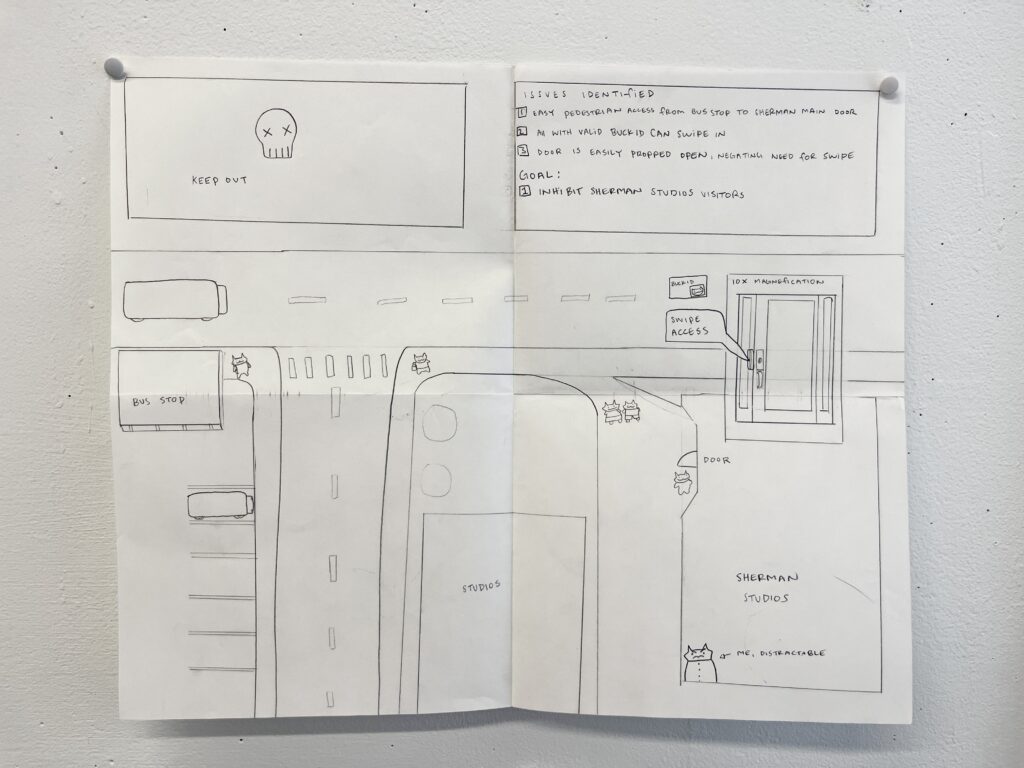
Here is the score that visitors desiring to enter Sherman tend to follow.
- They are dropped off by a CABS bus at a bus stop that is in easy walking distance from the building.
- Some people also cross from the parking lot located beside the bus stop.
- They cross the helpful cross-walk that leads onto the sidewalk that then leads into the building.
- They maneuver through the main door, which is behind a swipe lock.
- Anyone with a valid BuckID is able to swipe in
- The door is easily propped open and often is during typical school hours.
I noticed that there are not only sensors they interact with in order to enter the building through the swipe lock, but that there are also a number a physical infrastructures that contribute to the ease of accessing the building. As it is a school building, this is understandable, but for my purposes completely unacceptable.
I devised the following diagram that I think would really help limit the amount of students coming to the building.
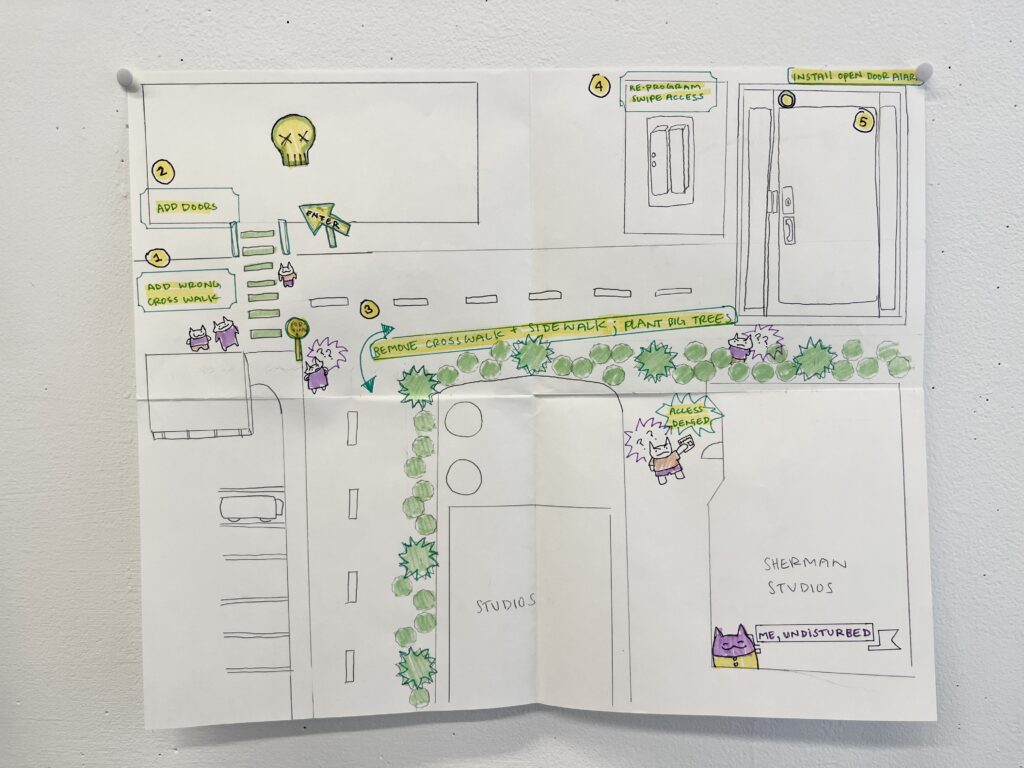
- Short of destroying the CABS system altogether, I think a key issue is the crosswalk, which provides a helpful direction to follow. I would first add in a crosswalk that goes a different way (towards a large dangerous looking electrical structure).
- The structure is currently behind tall fences, so I would need to add doors that are directly across from the new crosswalk.
- Remove the existing crosswalk with blacktop, or powerwash the paint away.
- Plant a thick privacy wall consisting of dense trees and bushes.
- Re-program the swipe access to only allow me swipe entrance.
- Add a door sensor that sends an alarm code if the door is propped open.
After talking to the class about my plot, I realize that I made a lot of really physical changes to the area. I think as a visual artist, a lot of the aspects like swipes and door sensors are mysterious to me, so it was easier for me to understand how to design more physical challenges to accessing the building. It was also pointed out to me that I didn’t address the parking lot, or really show how it would be possible for me to make it through the shrubbery. These are good points. I think ultimately it would be necessary to remove this bus stop, and frankly also the parking lot. The prices of West Campus parking passes could also be increased, as they are temptingly low cost compared to other passes. I also think I could do some easy sabotage by simply changing the building name on the front sign! It’s already almost impossible to find the building when doing a googlemaps search, so if it was physically mislabelled that would further confuse. Especially because I’m not sure how to make the trees move for me alone. Maybe I could install a fence with vines that completely obstruct the view of the building that has a hinged door. I could also install a camera at the door and do some data collecting, and only come to my studio during off-peak hours of activity in the building.
Also, as I actually want this building to be easily accessible because I unfortunately do want students to be able to make art in the building, there are the things I would do to make it easier to enter and use the building.
- Add more sidewalks. The front of the building only has a sidewalk leading into it from North, and none from the South. Students that park further away, or who walk from that direction, have to walk in the street which is dangerous and unpleasant during the winter.
- There should be a swipe access door on all sides of the building, rather than just that main entrance. This would make it easier for everyone to head straight to their destination rather than having to walk through the whole building.
- The main swipe door also isn’t ADA approved, as the only swipe is directly in front of the door at a high height, and the door opens out rather than in. There isn’t enough room for a person using a wheelchair to swipe and move away from the door so the button can swing the door open.
- There should be a hands free way to open the door. This could be a tap lock rather than a card swipe.
- The building currently doesn’t have air conditioning, and since it is a building with a hot-shop in the glass studio and a forge in the metal-working area, the building gets much too hot for safe use.
- The building needs a water-bottle refilling station rather than just drinking fountains. Because of the stuffy interior and physical nature of the work students make, they get really dehydrated.
I enjoyed this project. It made me appreciate the ways it is easy to work in my building, and also notice the ways it’s difficult for me and others. I appreciate there are certain ways to fix the user experience of the building that are out of budget, and that propping the door open at all times allows for those with mobility impairments to enter the building without needing to swipe in. However, propping the door open is not a viable solution during the cold wet winter. I haven’t used this space in the winter yet, so I’m interested to see how the people that use this building adapt during seasonal changes.
Duque bumping old discussion
Posted: August 26, 2024 Filed under: Uncategorized Leave a comment »https://dems.asc.ohio-state.edu/wp-admin/post.php?post=3321&action=edit